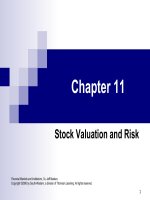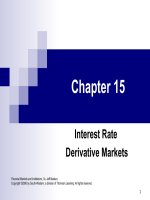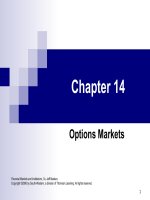Thị trường tài chính và các định chế tài chính Madura
Bạn đang xem bản rút gọn của tài liệu. Xem và tải ngay bản đầy đủ của tài liệu tại đây (77.89 KB, 9 trang )
An exchange rate is the price of one currency in terms of another.
True
False
status: not answered ()
correct: true
your answer:
2
The U.S. economy is the most dependent on trade in the world.
True
False
status: not answered ()
correct: false
your answer:
3
The capital account consists of foreign direct and indirect investment.
True
False
status: not answered ()
correct: true
your answer:
4
Which of the following may affect international trade flows?
a. inflation
b. national income
c. government restrictions
d. All of the answers are correct.
status: not answered ()
correct: d
your answer:
5
Transactions reflecting inflows of funds generate credits.
True
False
status: not answered ()
correct: true
your answer:
6
The capital account includes:
a. foreign income on U.S. dividends.
b. foreign investments in equity.
c. foreign purchases of goods.
d. foreign transfer payments.
status: not answered ()
correct: c
your answer:
7
The balance of payments records transactions:
a. between the U.S. and China.
b. between the U.S. and all other countries in the world.
c. involving only governments.
d. involving only tangible goods.
status: not answered ()
correct: b
your answer:
8
The U.S. has had a current account surplus for 40 years.
True
False
status: not answered ()
correct: false
your answer:
9
A country with a merchandise trade surplus necessarily has a current account surplus.
True
False
status: not answered ()
correct: false
your answer:
10
Merchandise trade involves both goods and services.
True
False
status: not answered ()
correct: false
your answer:
11
The balance of payments is a set of accounts showing:
a. tax laws of foreign governments.
b. transactions between domestic and foreign residents.
c. only the dollar value of imports.
d. only U.S. payment for foreign goods.
status: not answered ()
correct: b
your answer:
12
The U.S. has a trade deficit only because politicians have not been able to get favorable
trade deals.
True
False
status: not answered ()
correct: false
your answer:
13
Tariffs attempt to:
a. increase the costs of imports by adding a tax to the price.
b. increase the costs of imports by limiting the number that can be imported.
c. push exports in foreign markets.
d. reduce a capital account surplus.
status: not answered ()
correct: a
your answer:
14
All exports are of tangible goods.
True
False
status: not answered ()
correct: false
your answer:
15
Factor income refers to:
a. income received by investors on foreign investments.
b. only dividend income received by investors.
c. gifts received from foreign entities.
d. income received from services.
status: not answered ()
correct: a
your answer:
16
An example of foreign portfolio investment is:
a. a U.S. company setting up a subsidiary in Germany.
b. a U.S. hedge fund buying debt of foreign companies.
c. a joint venture owned 50-50 by U.S. and foreign partners.
d. an acquisition of a Korean firm by a French firm.
status: not answered ()
correct: b
your answer:
17
The balance of payments utilizes double-entry bookkeeping.
True
False
status: not answered ()
correct: true
your answer:
18
Which is true about the balance of payments?
a. It always balances.
b. A given account may have a deficit or surplus.
c. Transactions reflecting inflows of capital are credits.
d. All of the answers are correct.
status: not answered ()
correct: d
your answer:
19
The balance of payments always balances.
True
False
status: not answered ()
correct: true
your answer:
20
Which of the following are examples of foreign direct investment?
a. The purchase of a car manufacturing plant in the U.S. by a Japanese company.
b. A private investor in the U.S. buying 5% of the equity of a Japanese company.
c. Deposits of currency in foreign bank accounts.
d. Purchases of an insurance policy by a foreign individual.
status: not answered ()
correct: a
your answer:
21
The term international monetary system refers to the framework in which:
a. international payments are made.
b. the price of one currency in terms of another is determined.
c. deposit accounts in different currencies are established.
d. the exchange of international currency is coordinated.
status: not answered ()
correct: b
your answer:
22
The General Agreement on Tariffs and Trade:
a. resulted in an increase in tariffs around the world.
b. resulted in a decrease in tariffs around the world.
c. was beneficial to exporting firms.
d. b and c.
status: not answered ()
correct: d
your answer:
23
The current account components are:
a. merchandise trade.
b. services.
c. capital account.
d. a and b only.
status: not answered ()
correct: d
your answer:
24
The merchandise trade balance involves:
a. net exports or imports of tangible goods.
b. net exports or imports of goods and services.
c. net exports or imports of goods, services, and factor income.
d. net exports or imports of goods, services, factor income, and transfers.
status: not answered ()
correct: a
your answer:
25
Buying equity in a foreign entity is always foreign direct investment.
True
False
status: not answered ()
correct: false
your answer:
26
The term "exchange rate" refers to:
a. deposits of currency in more than one currency.
b. loans of dollars to foreign entities.
c. the change in interest rates over time.
d. the price of one currency in terms of another.
status: not answered ()
correct: d
your answer:
27
If official reserves are close to zero, then a country with a current account deficit
(surplus) will have a capital account surplus (deficit).
True
False
status: not answered ()
correct: true
your answer:
28
The international monetary system is the framework in which exchange rates are
established.
True
False
status: not answered ()
correct: true
your answer:
29
Which of the following are objectives of the IMF?
a. to provide loans for development
b. to promote capital mobility
c. to promote stability of exchange rates
d. b and c
status: not answered ()
correct: d
your answer:
30
Factor income is an account in the capital account.
True
False
status: not answered ()
correct: true
your answer:









